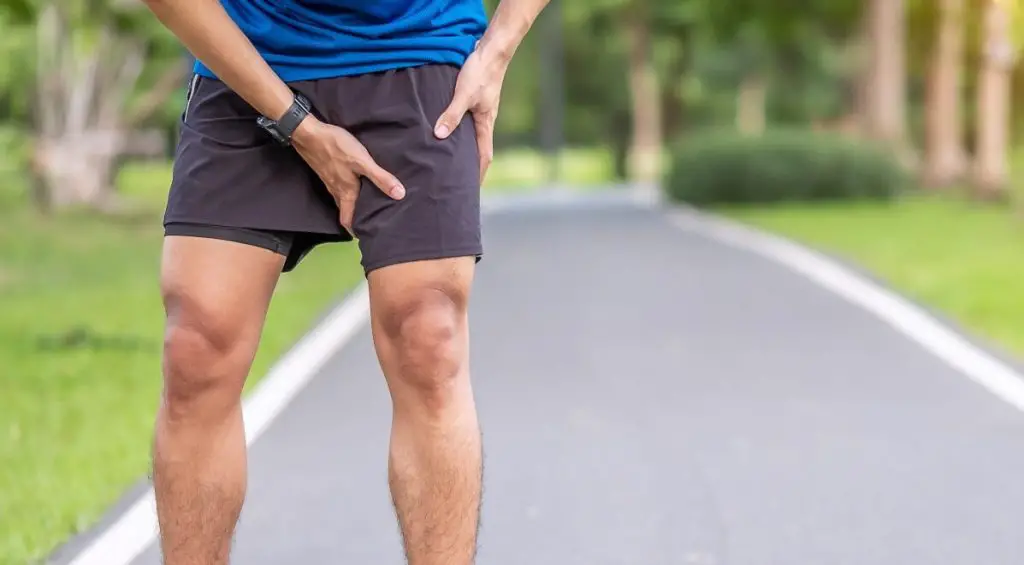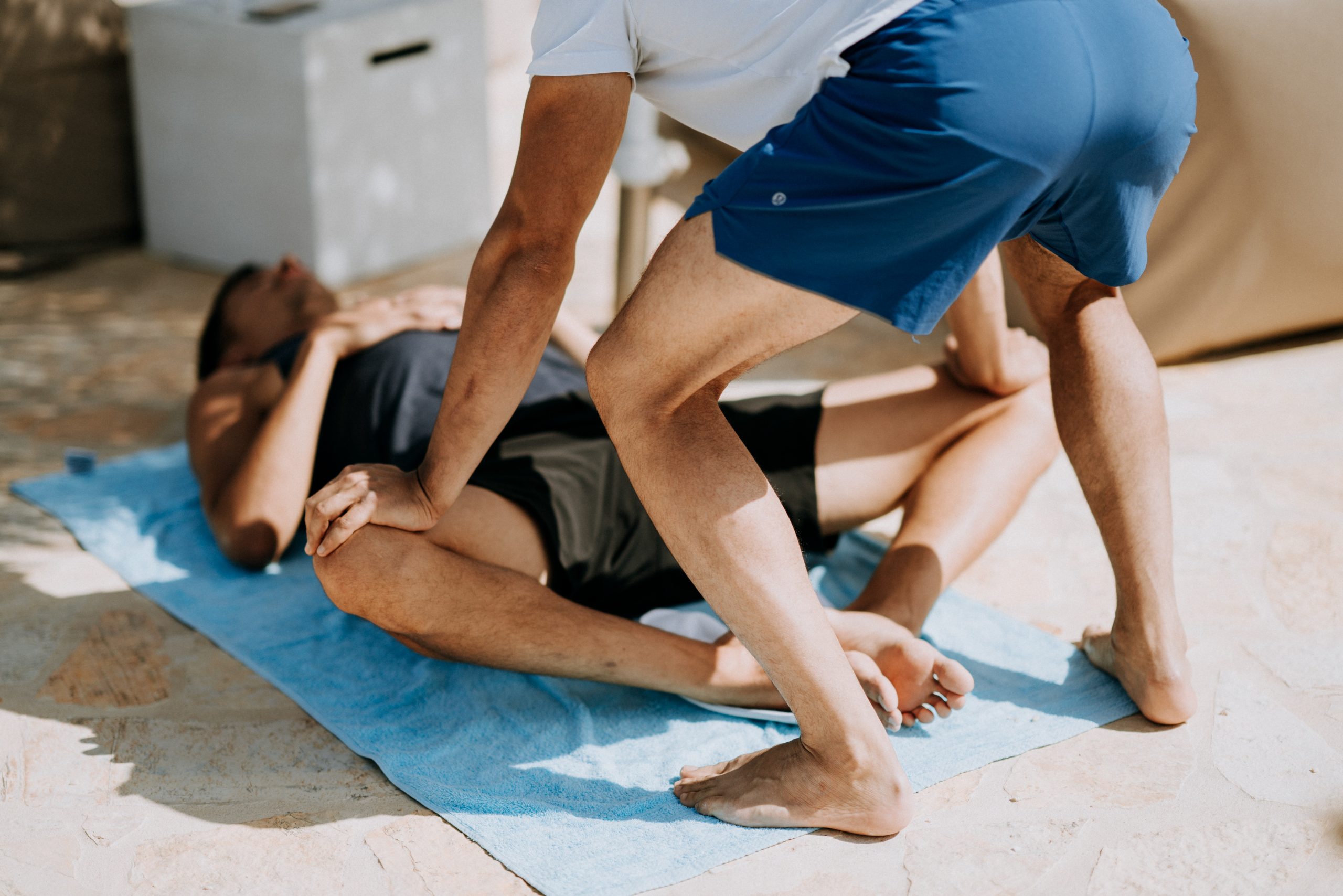Article reviewed and approved by Dr. Ibtissama Boukas, physician specializing in family medicine
La pubalgia is pain in the pubis that constitutes a common injury among athletes, especially footballers. It affects different groin muscle areas. It is also commonly called groin pain. Let’s take stock of this pathology: causes, symptoms, diagnoses and treatments.
Definition and anatomy
The word pubalgia means pain (algia) in the pubic area (pub). It is located at the union of the hip bones (in front, between the thighs).
Pubalgia in men and women
The word pubalgia is regularly used to refer to pain in the abdominal region lower, in the groin and on the upper thigh (especially in the adductors, which are the muscles on the inside of the thigh).
This pain syndrome is usually associated with sports practice, whether recreational or competitive sports. Both men and women can suffer from it.
Some women may also experience groin pain during pregnancy, from the sixth month. This usually comes from the pressure generated by the baby in the pelvis.
Groin pain: link with the intestine and the adductors
If bowel and adductors are involved, the pubalgia results in a sharp and brutal pain starting from the pelvis. It results from a inflammation in the insertion area of abdominal muscles at the upper edge of the pubis and adductor muscles.
The insertions of the rectus abdominis and adductor longus muscle exert nearly opposite forces on the symphysis. The slightest alteration in the balance of this antagonism is one of the classic causes of pubalgia in the athlete.
Causes of pubalgia
Le pubalgia syndrome can have many causes.
The pregnancy
If the pregnant woman is also a victim of pubalgia, it is because during pregnancy the body is subject to many anatomical and physiological changes so that it is ready to welcome the future baby.
You are probably wondering why such pain would be felt by the pregnant woman knowing that the body is supposed to adapt as much as possible to the stresses of pregnancy.
So, yes, the body adapts well, and one of the adaptation mechanisms is the secretion of specific hormones that will promote distention of the pelvis by causing a ligament hyperlaxity muscles in the pubic region.
However, at a certain point in the pregnancy, Baby's volume begins to weigh down and exerts more pressure on the lower abdomen until irritation or even inflammation of the muscles appears.
Abdominal distension, as well as changes in the curvatures of the back, also play an important role in the genesis of pubalgia. Indeed, these factors tend to cause an external rotation of the lower limbs, which constrains the adductor muscles which are solicited more when walking.
We cannot speak of pubalgia during pregnancy without mentioning the relaxin. It is in fact this hormone that is largely responsible for the pubalgia during pregnancy.
In the normal state, this hormone is secreted just before childbirth, to allow the uterus to expel the fetus. But, it sometimes happens that relaxin is secreted even before the pregnancy comes to term. This is responsible for intense pain from excessive movement.
How does pubalgia manifest during pregnancy?
La groin pain, as its name suggests, is felt in the groin or pubic area. Its intensity is variable and depends on the degree of ligament laxity as well as Baby's excessive movements.
It can be mild or moderate in some pregnant women, but very intense and throbbing in others.
If we refer to the circumstances of the pain, pubalgia is essentially triggered when moving from the rest phase (lying or sitting) to standing or walking. At first, the pain is bothersome but bearable, then increases until it limits or even completely prevents walking.
As the pregnancy advances in term, the pubalgia tends to radiate to the areas surrounding the pubis. Indeed, it can be felt on the inner part of the thighs, or a little lower in the leg (mimicking the pain of la sciatica), or in the lower back.
In the event that the pubalgia is atypical or is limited to its irradiations, it would be appropriate to consult your gynecologist so as not to miss a more serious cause (probably of gynecological origin) which would require more adequate care. .
When in pregnancy does pubalgia appear?
Classically, pubalgia appears from the 3rd quarter or to the 6th or 7th month of pregnancy. But, it can develop a little earlier in a certain number of future mothers. That is to say in the case where the body lets go a little rather in the face of certain circumstances, such as:
- A pelvic dystocia: the mother's pelvis is too narrow to receive and expel the baby
- The twin pregnancies ou Outputs
- Macrosomia: Baby with a weight of more than 4kg, frequent consequence of maternal diabetes
- polyhydramnios: excess amniotic fluid in which the fetus bathes.
Sport
Being extrinsic factors, causes of pubalgia in athletes are usually related to type of surface in practiced sport and shoes used by the athlete.
Many athletes show a pubalgia due to surface change. A change of terrain requires a rehabilitation of the musculature to achieve better stability of the whole body. However, this is difficult to achieve due to the intensity and frequency of the matches played. So themusculoskeletal system does not have enough time to adapt to the change of surface.
The sporting disciplines most likely to cause pubalgia are those that include acceleration, deceleration et sudden changes in direction. We can cite :
- football ;
- tennis ;
- athletics (triple jump, obstacle courses);
- ski.
The same is true for disciplines that require maintaining stability, such as gymnastics and ballet.
Anatomical factors
The anatomical factors can be atorigin of pubalgia group together:
- shortening of a lower limb;
- hip dysplasia;
- la spondylolysis ;
- abdominal wall deficits;
- thelumbar hyperlordosis.
Link between pubalgia and stress
Many people wonder if pubalgia could be related to stress. Although it is not the main culprit of this condition, certain elements can make believe that stress could contribute negatively to pubalgia.
Negative impact of stress
When it is minimal, the stress represents a natural and essential reaction allowing the body to adapt to unexpected situations. On the other hand, when it becomes too frequent or even almost permanent, it can be very harmful to both mental and physical health.
Indeed, intense and prolonged stress can induce physical manifestations such as pain, digestive disorders and insomnia; emotional manifestations such as anxiety, nervousness, irritability, crying spells or even sadness; and intellectual manifestations such as impaired concentration and attention.
It can also lead to pathologies that sometimes have serious consequences such as cardiovascular diseases (high blood pressure, myocardial infarction, etc.), metabolic syndrome, type II diabetes, depression and anxiety disorders.
It is also involved in the occurrence of musculoskeletal disorders due to permanent tension and negatively impacts the immune system, thus causing excessive inflammatory reactions.
What is the link between pubalgia and stress?
As explained previously, the pubalgia is a pain whose pathogenesis includes inflammation of the pubic symphysis, sudden movements on poorly heated muscles and anatomical factors.
Pubalgia could therefore be, in part, indirectly caused and maintained by stress. Indeed, it plays a role in inflammation through inflammatory cytokines circulating into muscle tissue and joint spaces.
These cytokines also participate in lowering the pain threshold, making them more sensitive to this sensation and therefore seem to promote the onset of pubalgia and contribute to their persistence.
Stress also often plays a role in the occurrence of muscle tension, spasms and contractions, which in itself causes pain, but can also be the cause of muscle tears sometimes manifesting as pubalgia.
Finally, the pubalgia is a pain testifying to pathologies generally encountered in professional sportsmen who very often have to participate in high-level competitions such as footballers, tennis players, rugby players, etc.
These competitions are, given the stakes, a source of great stress, which undoubtedly favors the occurrence of injuries.
Symptoms of pubalgia
The pubalgia symptoms may vary and tend to increase over time, until they radiate entirely over the entire surface of the thigh. The source of pain is located in the groin or lower abdomen. It usually appears after a workout or at the end of a strenuous physical activity. Afterwards, she begins to make herself felt during the activity physical.
She even ends up showing up for a few moments after the start of an activity and prevents its execution. There, the pain becomes persistent, until you are at rest, which prevents you from doing simple movements.
Moreover, if we refer to the duration of the symptoms, we can distinguish two types of pubalgia.
Acute pubalgia
It is characterized by a sudden pain that appears during the practice of a sport. Most often, it testifies to the existence of a muscle damage in the adductors or other muscles of this region. To be certain of the diagnosis, it is important to identify the nature and type of the lesion.
Chronic pubalgia
We are talking about chronic pubalgia when the pain lasts 3-6 months (or more). It is the most common ailment in sports.
During these chronic conditions, it is very important to rule out the existence of a hernia (inguinal or femoral) as well as pathology in the hip joint (such as hip osteoarthritis).
Diagnosis: How to detect pubalgia?
Le diagnosis of athlete's pubalgia syndrome is based on two principles:
- know the structure causing the pain (tendon, muscle, bone, etc.);
- identify the reason for this pain (inflammation, rupture, alteration of normal structure, etc.).
It is also mandatory to screen for possible changes, imbalances and biomechanical asymmetries may be the cause ofonset of groin pain.
Once the medical history is obtained, further studies should be performed.
- Ultrasound : an examination that will show the inflammatory process in the tendon area and its insertion.
- X-rays : they allow the visualization of the bone, the inflammatory characteristics, the small bone excretions on the upper edges of the pubis, towards the abdominal muscles, and lower, towards the adductor muscles.
- Magnetic Resonance Imaging (MRI): in case of doubt, she could demonstrate, in addition to all this inflammatory process previously described by ultrasound, the possible presence ofbone edema, giving edges of severity to the array.
Pubic Pain Treatments and Remedies
Natural and homeopathic treatments for groin pain
If pubalgia is intense, You can apply ice (cold) on the painful area. Ice is a common method for ease the pain and it can be very useful for coping with pubalgia. To do this, press ice regularly (for 15 minutes with breaks of at least 2 hours between each application) against the affected area to reduce swelling and associated pain.
A hot water bottle on the stomach or groin can also help and will bring the blood to the surface and activate blood circulation. This will stimulate the healing of muscle tissue and avoid spasms.
THEhomeopathy has also gained popularity due to its health benefits. When you are dealing with pubalgia, certain homeopathic medicines used in rheumatology such as Calcarea phosphorica can be used as background therapy. In the event of a pain crisis, the Route Graveolens can also help. Between drugs and surgery, homeopathic treatment can intervene to speed up the recovery process.
Physiotherapy to treat pubalgia
Within the framework of the pubalgia, le rehabilitation program ou physiotherapy treatment intended to :
- reduce pain;
- return joint function to normal;
- recreate good flexibility and rebalance muscles;
- regain adequate muscle strength.
In the functional rehabilitation program a pubalgic syndrome, the recovery exercises concern the musculotendinous structures directly affected: the long adductor, the rectus abdominis and the iliopsoas.
The number of sessions as well as the type of exercises vary depending on the cause of the pain (rupture, tendonitis, tendinosis, bursitis, etc.).
Apart from physical exercises, the physiotherapist also gives you indications on the good management of the loads.
Physio helps reduce inflammation and pain. It is based on isometric exercises of the adductors, rectus abdominis and accessory muscles. These exercises will then be progressed and adapted to your needs.
Surgery
La surgery comes into play when there is no improvement in pain with a conservative treatment. The causes of pubalgia most often requiring surgery are :
- the inguinal pathologies (inguinal canal or changes in other structures of the abdominal wall);
- the hip pathologies (femoroacetabular impingement or labral changes).
How to sleep with pubalgia?
It is easy to conceive that if our adductor pain makes us suffer at night, our quality of sleep will inevitably be affected. That's why it's important to find a comfortable sleeping position that can optimize your sleep and reduce stress on the inguinal region.
In the presence of pubalgia, I often recommend that my clients adopt one of the following positions to see if there is a beneficial effect on the level of symptoms.
1. Lying on your back with a pillow under your knees
This position reduces the anteversion of the pelvis (lumbar hyperlordosis), which reduces stress on the psoas muscle and hip flexors. For people who see their symptoms worsen when they arch their back, this position can be comfortable and thus improve the quality of sleep.
2. Lying on your side with a pillow between your legs
Keeping a pillow between the legs allows for a reduction in hip adduction movement. This is more comfortable for many people with pubalgia.
For added comfort, many of my patients opt for a knee pillow such as thereof, available on Amazon (affiliate link).
3. Lying on your stomach
If you are used to sleeping on your stomach, placing a pillow can reduce the pressure on the inguinal region and thus reduce the symptoms. This position also avoids lumbar hyperlordosis and tensioning of the psoas muscle (and other hip flexors).
Consult the products of Cervi-Care if you are looking for a orthopedic, ergonomic or shape memory pillow to reduce stress on the cervical region.
References
https://www.doctissimo.fr/forme/accidents-sportifs/accident-musculaire/pubalgie
https://www.santemagazine.fr/sante/fiche-maladie/pubalgie-894343
https://saintesante.com/homeopathie/maladies-traitees/pubalgie-et-homeopathie
https://douleurs-musculaires.ooreka.fr/comprendre/pubalgie
https://www.sport-orthese.com/blog/le-sport-et-la-pubalgie-n67




